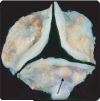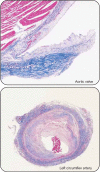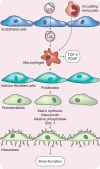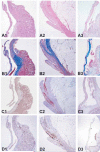Is it time for medical therapy for aortic valve disease?
- PMID: 15500430
- PMCID: PMC3951874
- DOI: 10.1586/14779072.2.6.845
Is it time for medical therapy for aortic valve disease?
Abstract
Calcific aortic stenosis is the most common indication for surgical valve replacement. Currently there are no medical therapies approved for the treatment of this disease. This review will summarize the clinical and experimental studies published over the past 5 years that indicate that medical therapy may be an option for this patient population.
Figures






Similar articles
-
Prognosis and risk factors in patients with asymptomatic aortic stenosis and their modulation by atorvastatin (20 mg).Am J Cardiol. 2008 Sep 15;102(6):743-8. doi: 10.1016/j.amjcard.2008.04.060. Epub 2008 Jul 2. Am J Cardiol. 2008. PMID: 18774000 Clinical Trial.
-
A randomized trial of intensive lipid-lowering therapy in calcific aortic stenosis.N Engl J Med. 2005 Jun 9;352(23):2389-97. doi: 10.1056/NEJMoa043876. N Engl J Med. 2005. PMID: 15944423 Clinical Trial.
-
Statins for aortic stenosis.N Engl J Med. 2005 Jun 9;352(23):2441-3. doi: 10.1056/NEJMe058070. N Engl J Med. 2005. PMID: 15944429 No abstract available.
-
Calcific aortic stenosis: lessons learned from experimental and clinical studies.Arterioscler Thromb Vasc Biol. 2009 Feb;29(2):162-8. doi: 10.1161/ATVBAHA.107.156752. Epub 2008 Nov 20. Arterioscler Thromb Vasc Biol. 2009. PMID: 19023094 Free PMC article. Review.
-
Prevention of calcific aortic valve stenosis-fact or fiction?Ann Med. 2009;41(2):100-8. doi: 10.1080/07853890802331394. Ann Med. 2009. PMID: 18720096 Review.
Cited by
-
Reduced EGFR causes abnormal valvular differentiation leading to calcific aortic stenosis and left ventricular hypertrophy in C57BL/6J but not 129S1/SvImJ mice.Am J Physiol Heart Circ Physiol. 2009 Jul;297(1):H65-75. doi: 10.1152/ajpheart.00866.2008. Epub 2009 May 15. Am J Physiol Heart Circ Physiol. 2009. PMID: 19448146 Free PMC article.
References
-
- Lindroos M, Kupari M, Heikkila J, Tilvis R. Prevalence of aortic valve abnormalities in the elderly: an echocardiographic study of a random population sample. J. Am. Coll. Cardiol. 1993;21(5):1220–1225. - PubMed
-
- Bonow RO, Carabello B, de Leon AC, Jr, et al. Guidelines for the management of patients with valvular heart disease: executive summary. A report of the American College of Cardiology/American Heart Association Task Force on Practice Guidelines (Committee on Management of Patients with Valvular Heart Disease). Circulation. 1998;98(18):1949–1984. [Current American College of Cardiology (ACC)/American Heart Association (AHA) guidelines for cardiac evaluation for patients with valvular heart disease. Contains a very thorough review of the entire literature in the English language on the management of aortic valve disease.] - PubMed
-
- Stokes W. The Diseases of the Heart and Aorta. Hodges & Smith; Dublin, Ireland: 1645. pp. 211–212.
-
- Chan KL. Is aortic stenosis a preventable disease? J. Am. Coll. Cardiol. 2003;42(4):593–599. - PubMed
-
- Stewart BF, Siscovick D, Lind BK, et al. Clinical factors associated with calcific aortic valve disease. Cardiovascular Health Study. J. Am. Coll. Cardiol. 1997;29(3):630–634. [The Cardiovascular Health Study was the first epidemiologic study to demonstrate the independent risk factors for calcific aortic stenosis.] - PubMed
MeSH terms
Substances
Grants and funding
LinkOut - more resources
Full Text Sources
Medical
Miscellaneous
